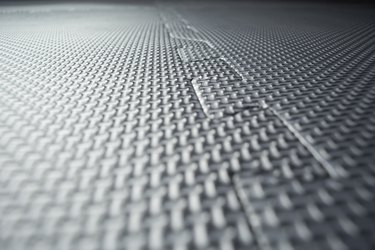
Slip resistant and low maintenance, rubber flooring is often found on gym floors and in industrial settings. Rubber floors are also used in homes to pad private fitness studios, garages and playrooms. These floors are easy to maintain, but they do need a bit of attention from time to time to keep them looking their best.
Rubber flooring needs periodic vacuuming to stay clean. When there's a bit more dirt than your vacuum alone can handle, cleaning is a simple matter of mopping the floor with some warm water and a nylon mop.
Video of the Day
Video of the Day
Sweeping and Vacuuming
Rubber floors are pretty resilient, but dirt and debris can scratch them, especially when they are dragged across the floor. To avoid this problem, BuildDirect recommends that you sweep or vacuum your floor at least once a week. In high-traffic areas, however, you may need to give the floor a quick vacuuming or sweeping daily.
If you choose to vacuum, choose a vacuum cleaner with a soft beater brush. To avoid damaging the rubber, set the floor height on the vacuum cleaner to medium. This will sweep up debris without gouging your floor. It will also make the vacuum cleaner easier to push across the floor.
Basic Mopping Tips
A weekly mopping will keep your rubber flooring in good shape, and it's easy to do. In most cases, you can simply damp mop with a bucket of warm water. Unless you're battling tough stains, your floor should come clean without the help of any cleaning solutions. Make sure you use a nylon mop or soft-bristled brush when mopping rather than a cotton or sponge mop, however. Sponges and cloths tend to snag on the rubber's textured surface, leaving unsightly lint behind.
If you feel better using a cleaner when you mop or have a floor that sees a lot of foot traffic, you can add a bit of dish soap to your mop water. Do so sparingly. Cleaning solutions can leave behind a filmy residue when used to clean rubber, and removing it requires a lot of mopping with plain water. When you're done mopping, allow the floor to air dry or use a wet/dry vacuum to suck up the water.
If your rubber floor is brand new, Brush Technology suggests waiting 72 hours before mopping it for the first time. Although it's tempting to want to remove any dust or debris left behind by the floor installation, waiting gives the glue under the floor time to set properly.
Tackling Tough Stains
If you spill something on your rubber floor, it's important to remove the stain with the correct solutions. In some cases, you may need a special rubber floor cleaner from the hardware store. Home remedies often work wonders, however, if you use them properly. There are some household cleaners you should always avoid, however, including bleach, strippers, degreasers and abrasives.
To remove water-based stains from rubber flooring, use a 50/50 solution of water and vinegar. Apply the solution to the floor, scrubbing it gently in a circular motion with a soft-bristled brush. Rinse the area well when you're finished.
For oil-based stains, dampen a cloth with 3 teaspoons of turpentine and blot the stain. Don't use more turpentine than recommended, as this can damage the floor when used in excess. When using turpentine, wear rubber gloves and ventilate your work area.
Rubber Tile Considerations
While some rubber flooring comes as a solid rubber sheet, some manufacturers offer rubber floor tiles. These convenient tiles are easy to install and allow you to swap out damaged tiles for fresh ones as needed. While the care of these floors is basically the same, there are some minor differences to note.
One is that you must avoid excess water on rubber tile floors. When scrubbing and mopping these tiles, it's possible for water and cleaning solutions to flow into the cracks between tiles and wet the subfloor beneath. To avoid this issue, always clean with a damp mop rather than a soaking wet one.
You should also move tiles around from time to time. Ordinarily, some parts of your rubber floor will see more foot traffic than others. The middle of the floor, for example, is probably used much more often than the edges. To combat uneven wear, move your floor tiles around periodically so one spot doesn't show wear before another.